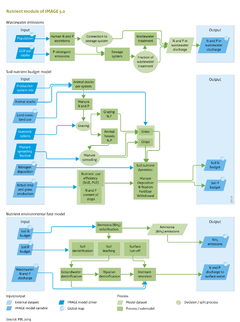Nutrients/Policy issues: Difference between revisions
Jump to navigation
Jump to search
m (Text replace - "Roads from Rio+20 (2012)" to "Roads from Rio+20 (2012) project") |
No edit summary |
||
| Line 1: | Line 1: | ||
{{ComponentPolicyIssueTemplate | {{ComponentPolicyIssueTemplate | ||
|Description=Under the baseline scenario of the [[Roads from Rio+20 (2012) project|Rio+20 study]], N surpluses increase by 35% globally | |Description=Under the baseline scenario of the [[Roads from Rio+20 (2012) project|Rio+20 study]], N surpluses increase by 35% globally. This is the result of decreasing trends in North America, western Europe and Japan, and stabilisation in India. In all other regions, N surpluses increase, particularly in Sub-Saharan Africa and Southeast Asia (see figure below). The situation is similar for phosphorus, with large increases in developing countries. | ||
Economic developments and policy interventions may modify individual terms in the soil nutrient budget ([[Equation 1]]), and the fate of nutrients in the environment. For example, agricultural demand ([[Agricultural economy and forestry]]) affects: | |||
# production of leguminous crops (pulses and soybeans) and biological N fixation as a consequence; | |||
* crop production and | # meat and milk production and thus animal manure production; | ||
# crop production and thus fertiliser use. | |||
[[***comment: PI of tekst?]] | |||
The IMAGE soil nutrient model includes options to reduce nutrient surpluses in agriculture or nutrients in wastewater, and strategies to improve resource use efficiency. Wastewater strategies that can be assessed with tools available in the nutrient model of IMAGE include: | |||
# Increasing access to improved sanitation and connection to sewerage systems; | |||
# Setting up wastewater treatment installations; | |||
# Substituting synthetic fertilisers with fertilisers produced from human excreta. This option has no consequences for nutrient budgets, but reduces wastewater flows. | |||
|Example=Extensification, increased feed efficiency and reduced ammonia emissions from stables (cases EX, FE and ST) have minor effects on the global soil N budget. However, better integration of animal manure in crop production systems (IM), primarily in industrialised countries, and a change in the human diet with poultry replacing ruminant meat (DI) would have major effects on the global soil N budget. | |||
Other options that can be assessed using scenario variables from other parts of IMAGE include: | |||
# Consequences of changes in crop production systems, such as increasing crop yields, that would improve fertiliser use efficiency; | |||
# Consequences of changes in livestock production systems such as better management leading to lower excretion rates; | |||
# Changes in the distribution of total production between mixed and pastoral systems; | |||
# Changing human diets leading to changing production volumes. | |||
}} | }} | ||
Revision as of 11:33, 12 February 2014
Parts of Nutrients/Policy issues
| Component is implemented in: |
| Components: |
| Related IMAGE components |
| Projects/Applications |
| Key publications |
